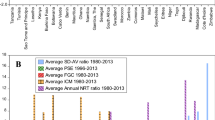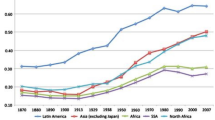Abstract
Political instability has become endemic to Sub-Saharan Africa. Since the early 1960s, when most of the African countries began to achieve independence, more than fifty coups have taken place in the continent. This rise in political decay has significantly affected economic development. This study examines the relationship between elite political instability and economic development in Sub-Saharan Africa. It concludes that lack of political stability has contributed significantly to economic stagnation in the continent of Africa.
Similar content being viewed by others
Notes
Patrick McGowan and Thomas Johnson, “Military Coups d’état and Underdevelopment: A Quantitative Historical Analysis,”Journal of Modern African Studies, Vol. 22 (December 1984), pp. 633–666.
World Bank,World Development Report 1983, (New York: Oxford University Press for the World Bank, 1983).
David Sanders,Patterns of Political Instability, (New York: St. Martin’s Press, 1981), pp. 59–63.
Donald G. Morrison and Hugh Michael Stevenson, “Political Instability in Independent Black Africa: More Dimensions of Conflict Resolution Within Nations,”Journal of Conflict Resolution, Vol. 15 (September 1971), p. 348; and Patrick McGowan, “Predicting Political Instability in Tropical Africa,” in Michael K. O’Leary and William D. Coplin,Quantitative Techniques in Foreign Policy Analysis and Forecasting (New York: Praeger, 1975), pp. 35–78.
Morrison and Stevenson, op. cit., “, p. 349.
See Morrison and Stevenson, p. 349.
McGowan, pp. 45–46.
See Morrison and Stevenson, pp. 349–354 and Douglas A. Hibbs, Jr.,Mass Political Violence: A Cross-National Casual Analysis, (New York: John Wiley and Sons, 1973), p. 7.
Organization for African Unity,The Lagos Plan of Action for the Economic Development of Africa 1980–2000 (Geneva: International Institute for Labour Studies, 1981).
World Bank,Accelerated Development in Sub-Saharan Africa: An Agenda for Action (Washington, D.C.: World Bank, 1981).
Ibid., pp. 24ff.
See Robert S. Browne and Robert J Cummings,The Lagos Plan of Action vs. the Berg Report: Contemporary Issues in African Economic Development, (Lawrenceville, VA: Brunswick Publishing Company, 1984); and Omotunde E.G. Johnson, review of “The Lagos Plan of Action vs. the Berg Report: Contemporary Issues in African Economic Development,”The Review of Black Political Economy, Vol. 14, No. 1 (Summer 1985), pp. 104–108.
Morrison and Stevenson, p. 354.
Ibid.
Ibid., p. 367. Also see McGowan, p. 55.
Hibbs, Jr., op. cit., pp. 21ff.
Ibid., p. 23. Also see Bruce M. Russett, Hayward R. Alker, Jr., Karl W. Deutsch, and Harold D. Lasswell,World Handbook of Political and Social Indicators, (New Haven: Yale University Press, 1964).
See Hibbs, Jr., op. cit., p. 24 and William H. Flanigan and Edwin Fogelman, “Patterns of Political Violence in Comparative Historical Perspective,”Comparative Politics, Vol. 3, No. 1 (October 1970), pp. 1–20.
Hibbs, Jr., pp. 25–26.
Ibid., p. 25.
Ibid., pp. 25–26.
Ibid., p. 28.
E. Wayne Nafziger,The Economics of Developing Countries, (Belmont, CA: Wadsworth, 1984), pp. 11–12.
Douglas C. North,Structure and Change in Economic History (New York: W.W. Norton, 1981).
See Irving S. Friedman,The Emerging Role of Private Banks in Developing Countries (New York: Citicorp, 1977) and Jeff Madura,International Financial Management (St. Paul: West Publishing, 1986).
J. ’Bayo Adekson,Nigeria in Search of a Stable Civil-Military System, (Boulder CO: Westview, 1981).
Akin Adebayo, “Brain Drain Within the ECOWAS Region,”Issue: A Journal of Opinion, Vol. XIV (1985), pp. 37–38.
Nafziger, op. cit., pp. 11–12.
Ibid., pp. 26–28 and 30–33.
See David Colman and Frederick Nixson,Economics of Developing Countries (Belmont, CA: Wadsworth, 1978); and John M. Mbaku, “Measuring Economic Performance in Cameroon, 1972–1982,” Ph.D. Dissertation, University of Georgia, Athens, Georgia, 1985. Also see Nafziger, pp. 23–25.
See Morris David Morris,Measuring the Condition of the World’s Poor: The Physical Quality of Life Index (New York: Pergamon Press, 1979); David A. Brodsky and Dani Rodrik, “Indicators of Development and Data Availability: The Case of the PQLI,”World Development, Vol. 9, No. 7 (1981), pp. 695–699; and Norman Hicks and Paul Streeten, “Indicators of Development: The Search for a Basic Needs Yardstick,”World Development, Vol. 7, No. 6 (June 1979), pp. 567–580.
See Hicks and Streeten, op. cit.“ and Paul Streeten, “The Distinctive Features of a Basic Needs Approach to Development,”International Development Review, Vol. 19, No. 3 (1970), pp. 8–16.
Europa Publications Limited,Africa South of the Sahara 1986, (London, 1985).
Nafziger, op. cit., pp. 13–19 and Morris, op. cit.
UNESCO,Statistical Yearbook 1985, (Paris, 1985).
Adekson, op. cit., pp. 64–66.
SeeAfrica South of the Sahara 1986 and Mark Anikpo, “Achieving Self-Sufficiency in African Agricultural Food Production: The Case of Nigeria,”Africa Today, Vol. 32, No. 4 (1985), pp. 29–38.
McGowan and Johnson, op. cit.“ Also McGowan, p. 47.
Patrick J. McGowan,Intervention Event File (Tempe, AZ: Department of Political Science, Arizona State University, 1986).
Organization for Economic Cooperation and Development,Geographic Distribution of Financial Flows to Developing Countries 1981/1984 (Paris: OECD, 1986); World Bank,World Development Report, several issues, 1979–1986 (New York: Oxford University Press for the World Bank, 1979–1986); Daniel Gallik, (editor),World Military Expenditures and Arms Transfers 1987 (Washington, D.C.: United States Arms Control and Disarmament Agency, 1988); World Bank,Accelerated Development in Sub-Saharan Africa: An Agenda for Action (Washington, D.C: World Bank, 1981); World Bank,World Tables 1983, Vol. I (Baltimore: The Johns Hopkins University Press for the World Bank, 1983); E. Wayne Nafziger,The Economics of Developing Countries (Belmont, CA: Wadsworth, 1984); Morris David Morris,Measuring the Condition of the World’s Poor: The Physical Quality of Life Index (New York: Pergamon Press, 1979); Patrick J. McGowan,Intervention Event File (Tempe, AZ: Department of Political Science, Arizona State University, 1986).
SeeIntervention Event File, op. cit., and McGowan and Johnson, op. cit.
Patrick Utomi, “Legitimacy and Governance: One More Year of Military Rule in Nigeria,”Issue: A Journal of Opinion, Vol. XIV (1985), pp. 39–42.
About this article
Cite this article
Mbaku, J.M. Political instability and economic development in Sub-Saharan Africa: Some recent evidence. Rev Black Polit Econ 17, 89–111 (1988). https://doi.org/10.1007/BF02900956
Issue Date:
DOI: https://doi.org/10.1007/BF02900956




